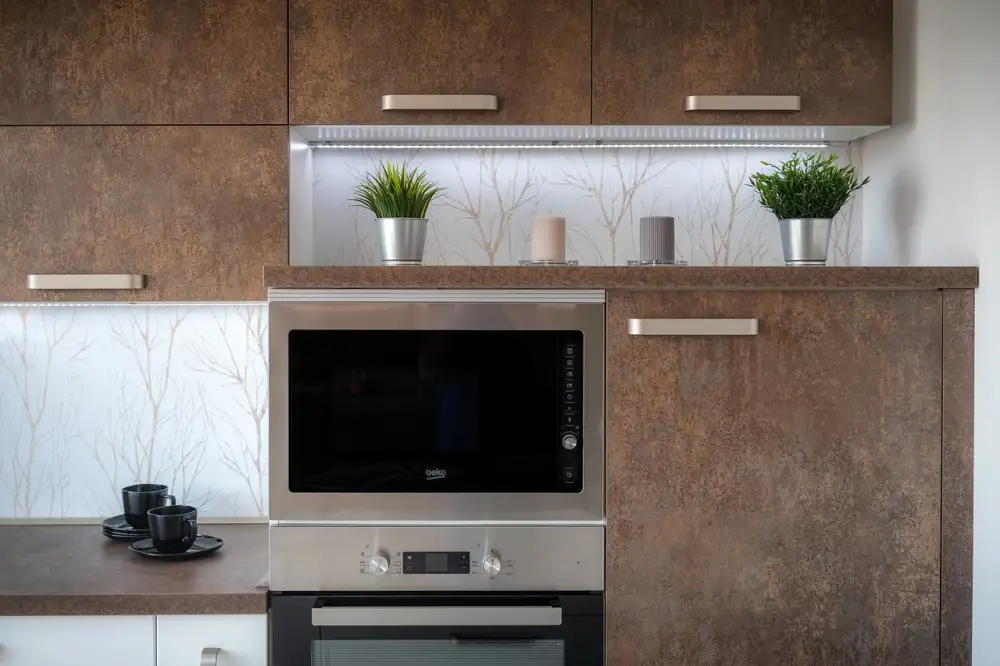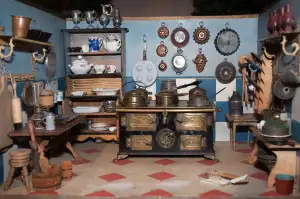Master the Art of Cooking with a Convection Oven: Your Ultimate Guide for Home Chefs

- Understanding the Basics of Convection Cooking
- Preheating Your Convection Oven
- Adjusting Cooking Time and Temperature
- Proper Placement of Cookware in the Convection Oven
- Using the Convection Setting for Baking
- Utilizing the Convection Setting for Roasting
- Tips for Achieving Perfectly Cooked Meals in a Convection Oven
- Cleaning and Maintenance of Your Convection Oven
Welcome to the world of convection cooking! If you're looking to take your culinary skills to the next level, a convection oven is a must-have appliance in your kitchen. Unlike traditional ovens, which rely on radiant heat to cook food, convection ovens use a fan and exhaust system to circulate hot air evenly throughout the oven cavity. This results in faster and more even cooking, with crispy exteriors and moist interiors. Whether you're baking, roasting, or broiling, a convection oven will revolutionize the way you cook. In this ultimate home guide, we will explore the basics of using a convection oven and provide you with expert tips and techniques to master this versatile appliance. So let's dive in and unlock the secrets of cooking with a convection oven!
Understanding the Basics of Convection Cooking
Convection cooking is a game-changer for home chefs, as it utilizes a fan to circulate hot air evenly around the food. This results in faster and more even cooking, with dishes that are crispy on the outside and moist on the inside.
The key principle behind convection cooking is that hot air surrounds the food, transferring heat more efficiently than traditional ovens. This allows for shorter cooking times and lower temperatures, saving both time and energy.
One important thing to note is that convection cooking can cause foods to cook faster than expected. It's crucial to keep an eye on your dishes and use a timer to prevent overcooking. Additionally, because of the increased airflow, it's recommended to reduce the temperature by about 25 degrees Fahrenheit or 15 degrees Celsius when using convection mode.
Convection ovens also excel at browning and crisping foods. The circulating hot air helps create a beautiful golden crust on baked goods like bread and pastries. It also enhances the caramelization process when roasting meats and vegetables, resulting in deliciously flavorful dishes.
By understanding these basics of convection cooking, you'll be able to take full advantage of your convection oven's capabilities and elevate your culinary skills to new heights. So let's dive deeper into how to make the most out of this incredible kitchen appliance!
Preheating Your Convection Oven
Preheating your convection oven is an essential step to ensure even and efficient cooking. Unlike traditional ovens, convection ovens rely on the circulation of hot air to cook food. Preheating allows the oven to reach the desired temperature before you start cooking, ensuring that your dishes are cooked evenly from start to finish.
To preheat your convection oven, simply turn it on and set the desired temperature. Most convection ovens have a preheat function that will automatically adjust the temperature and time needed for preheating. It's important to note that preheating times may vary depending on the size and model of your oven.
During the preheating process, make sure to remove any racks or accessories from the oven. This will allow for better airflow and ensure that the oven heats up more quickly and evenly. It's also a good idea to keep an eye on the oven thermometer to ensure that it reaches the desired temperature accurately.
Once your convection oven has reached the desired temperature, it's ready for cooking. Remember, unlike traditional ovens, there's no need to wait for additional time after preheating before placing your food in the oven. The hot air circulation in a convection oven allows for immediate cooking once it reaches the set temperature.
By taking the time to properly preheat your convection oven, you'll be setting yourself up for success in achieving perfectly cooked meals every time. So don't skip this crucial step - let your convection oven reach its full potential by giving it a proper preheat!
Adjusting Cooking Time and Temperature
One of the key benefits of cooking with a convection oven is its ability to cook food faster and more evenly. To make the most out of this feature, it's important to understand how to adjust the cooking time and temperature.
When using a convection oven, you can typically reduce the cooking time by about 25% compared to a conventional oven. This is because the hot air circulation in a convection oven helps food cook faster. However, keep in mind that every recipe may require different adjustments, so it's essential to monitor your dish closely.
In terms of temperature, you can generally lower it by about 25 degrees Fahrenheit (or 15 degrees Celsius) when using a convection oven. This is because the fan in the oven helps distribute heat more efficiently, resulting in even cooking. Remember to refer to your recipe as a starting point and make adjustments based on your specific convection oven model.
By adjusting both the cooking time and temperature, you can ensure that your dishes are cooked perfectly every time. Experiment with different settings and take note of any changes you make so that you can replicate successful results in the future.
Mastering these adjustments will allow you to unlock the full potential of your convection oven and create culinary masterpieces with ease. So don't be afraid to experiment and enjoy the benefits of faster, more even cooking!
Proper Placement of Cookware in the Convection Oven
Proper placement of cookware in a convection oven is crucial to ensure even cooking and optimal results. When using a convection oven, it is recommended to leave enough space around the cookware for proper air circulation. This allows the hot air to circulate evenly and cook the food uniformly.
To achieve this, make sure not to overcrowd the oven with too many dishes at once. Leave at least 1-2 inches of space between each dish and also between the dishes and the oven walls. This will allow the hot air to flow freely and distribute heat evenly.
Additionally, it is important to use shallow and flat-bottomed cookware whenever possible. This helps in promoting better airflow and heat distribution. Avoid using deep pans or dishes with high sides as they can obstruct the circulation of hot air, resulting in uneven cooking.
When placing multiple trays or racks in the convection oven, stagger them rather than aligning them directly on top of each other. This ensures that each tray receives adequate airflow for consistent cooking.
Lastly, always use oven-safe cookware that can withstand high temperatures without warping or melting. Check the manufacturer's instructions for recommended temperature limits before using any cookware in your convection oven.
By following these guidelines for proper placement of cookware in a convection oven, you can maximize its efficiency and achieve deliciously cooked meals every time.
Using the Convection Setting for Baking
Baking in a convection oven can produce amazing results, with even browning and perfectly risen cakes. To get the best out of your convection oven for baking, follow these tips:
1. Adjust the temperature: When using the convection setting, reduce the temperature by about 25 degrees Fahrenheit (or 15 degrees Celsius) compared to a conventional oven recipe. This is because the hot air circulation in a convection oven cooks food faster.
2. Use shallow pans: Opt for shallow baking pans or cookie sheets instead of deep ones. The hot air needs to circulate around the food evenly, and shallow pans allow for better airflow.
3. Rotate your trays: If you're baking multiple trays at once, rotate them halfway through the cooking time to ensure even browning. This helps prevent any hot spots that may occur due to the intense heat from the convection fan.
4. Keep an eye on baking time: Since convection ovens cook faster than conventional ovens, it's crucial to monitor your baked goods closely. Start checking for doneness a few minutes earlier than recommended in your recipe.
5. Avoid overcrowding: Leave enough space between your baked goods on the tray to allow proper air circulation. Overcrowding can lead to uneven cooking and hinder browning.
6. Use parchment paper or silicone mats: To prevent sticking and promote even browning, line your baking trays with parchment paper or silicone mats rather than greasing them.
By following these tips, you'll be able to achieve bakery-quality results when using the convection setting for baking in your oven. Experiment with different recipes and enjoy perfectly cooked treats every time!
Utilizing the Convection Setting for Roasting
Roasting is a popular cooking method that brings out the natural flavors and textures of meats, vegetables, and even fruits. With a convection oven, you can take your roasting game to the next level.
When using the convection setting for roasting, you'll want to follow a few key steps. First, preheat your oven to the desired temperature. The convection setting typically requires a slightly lower temperature than traditional roasting methods.
Next, prepare your meat or vegetables by seasoning them with your favorite herbs and spices. Place them on a roasting rack or in a shallow pan to allow air circulation around the food.
Once your oven is preheated, place the food in the center of the oven. The hot air circulating evenly will ensure that your roast cooks evenly from all sides.
Remember to adjust your cooking time accordingly. Convection ovens cook faster than conventional ovens, so keep an eye on your food to prevent overcooking. It's always best to use a meat thermometer to check for doneness.
The convection setting also helps achieve that perfect crispy exterior while keeping the inside moist and tender. This is especially beneficial when roasting poultry or cuts of meat with skin.
To enhance browning, you can periodically baste your roast with its own juices or brush it with melted butter or oil. This will give your dish an irresistible golden crust.
Don't forget about resting time! After removing your roast from the oven, allow it to rest for a few minutes before carving. This allows the juices to redistribute throughout the meat for maximum flavor and tenderness.
With practice and experimentation, you'll soon become a master at utilizing the convection setting for roasting in your home kitchen. So go ahead and impress your loved ones with perfectly roasted meals every time!
Tips for Achieving Perfectly Cooked Meals in a Convection Oven
1. Use the right cookware: Opt for pans and baking sheets with low sides to allow proper air circulation. Avoid using dark-colored or non-stick cookware, as they may cause food to cook too quickly.
2. Monitor cooking time: Since convection ovens cook food faster, it's crucial to keep an eye on your dishes to prevent overcooking. Start checking for doneness a few minutes before the recommended cooking time.
3. Rotate the pans: To ensure even browning and cooking, rotate the pans halfway through the cooking process. This helps distribute heat evenly and prevents any hot spots in the oven.
4. Reduce cooking temperature: Lowering the temperature by about 25 degrees Fahrenheit compared to traditional recipes is recommended when using a convection oven. This adjustment compensates for the faster cooking time.
5. Don't overcrowd the oven: Leave enough space between dishes to allow hot air to circulate freely around them. Overcrowding can affect the airflow and result in unevenly cooked food.
6. Use lower racks for crispy textures: For foods that require a crispy texture, such as pizza or roasted vegetables, place them on lower racks closer to the heat source. This allows them to crisp up nicely without burning.
7. Keep an eye on delicate foods: Delicate items like cakes and soufflés may rise more quickly in a convection oven due to increased air circulation. Check them frequently during baking and adjust cooking time if needed.
8. Use parchment paper or silicone mats: To prevent sticking and facilitate easy cleanup, line your baking sheets with parchment paper or silicone mats when using a convection oven.
By following these tips, you'll be well on your way to mastering the art of cooking with a convection oven and achieving perfectly cooked meals every time!
Cleaning and Maintenance of Your Convection Oven
Cleaning and maintaining your convection oven is essential to ensure its longevity and optimal performance. Here are some tips to keep your oven in top shape:
1. Regularly wipe down the interior of the oven with a damp cloth or sponge to remove any food residue or spills. Avoid using harsh chemicals that may damage the oven's surfaces.
2. Remove the racks and trays from the oven and wash them separately with warm soapy water. Scrub off any stubborn stains or grease buildup before rinsing and drying them thoroughly.
3. Clean the convection fan by gently removing any accumulated dust or debris with a soft brush or cloth. Be careful not to bend or damage the fan blades during this process.
4. Pay attention to the oven door, as it can accumulate grease and grime over time. Use a mild detergent mixed with warm water to clean both the inside and outside of the door, ensuring it is free from any dirt or residue.
5. If your convection oven has a self-cleaning function, follow the manufacturer's instructions for using this feature safely. This setting heats up the oven to high temperatures, burning off any food particles or spills, which can then be easily wiped away once cooled.
6. Regularly check and replace any worn-out seals around the door to maintain proper heat retention and prevent energy loss.
7. Finally, perform routine maintenance checks on your convection oven by inspecting its heating elements, controls, and ventilation system for any signs of damage or malfunction. If you notice anything unusual, contact a professional technician for assistance.
By following these cleaning and maintenance guidelines, you can ensure that your convection oven remains in excellent condition, allowing you to continue creating delicious meals with ease for years to come.
In conclusion, cooking with a convection oven can elevate your culinary skills to new heights. By understanding how convection ovens work and properly preparing and adjusting cooking times and temperatures, you can achieve perfectly cooked dishes every time. Whether you're baking delicate pastries or roasting succulent meats, the convection setting will ensure even heat distribution for consistent results. Remember to follow our tips for using a convection oven properly, and don't forget to clean and maintain your oven regularly to prolong its lifespan. With practice and patience, you can truly master the art of cooking with a convection oven and create delicious meals that will impress your family and friends. So go ahead, unleash your creativity in the kitchen, and let your passion for food shine through every dish you prepare!
Published: 12. 01. 2024
Category: Home



